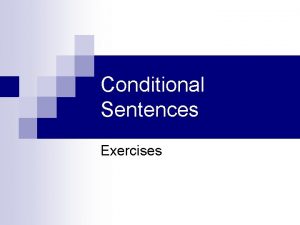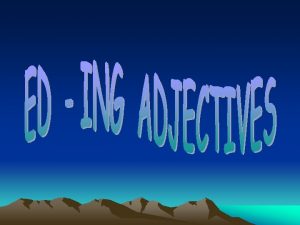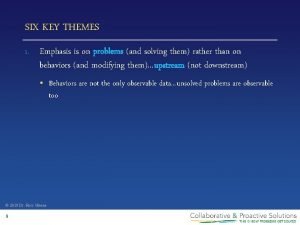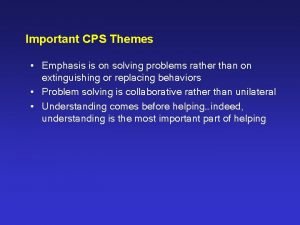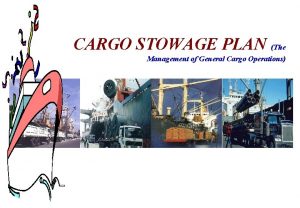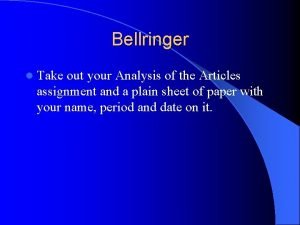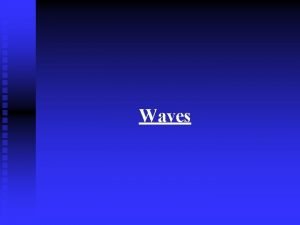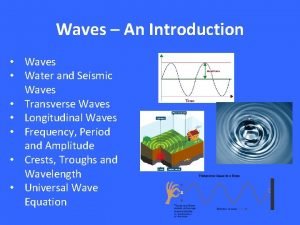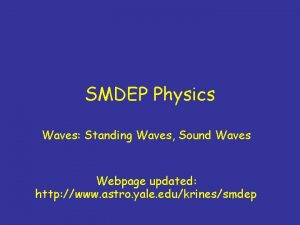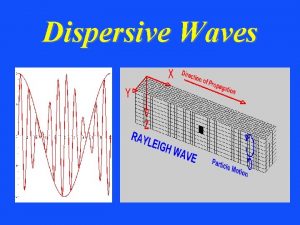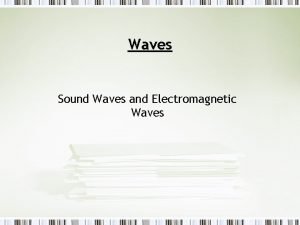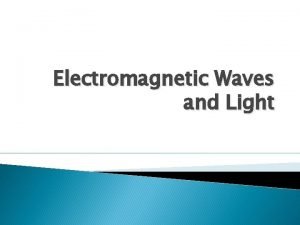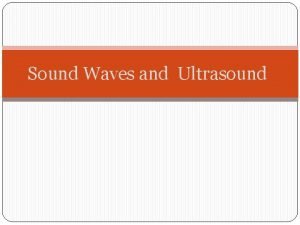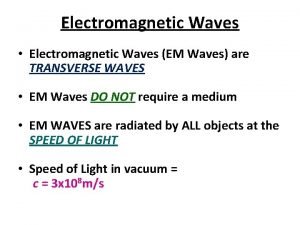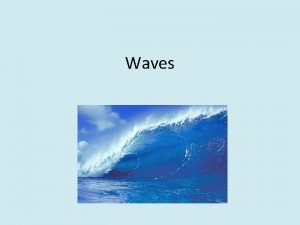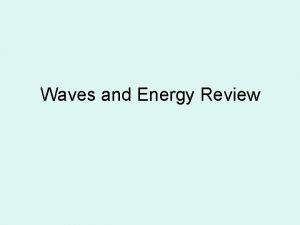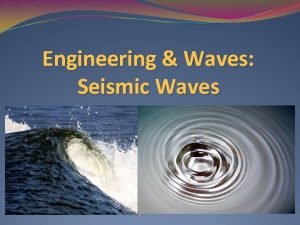Plan Waves What are they How do they



































- Slides: 35

Plan Waves - What are they - How do they happen - What do they do Tides - What they are - How they happen - Tide mapping assignment (different beaches)

Anatomy of a Wave

Anatomy of a Wave • The crest - is the high point of the wave. • The trough - is the low point of the wave. • Wave height - is the vertical distance between the top of the crest and the bottom of the trough. • Wavelength - is the distance between one wave crest and the next.

How are waves and energy related? • I have tied a piece of rope tied to the door handle. • Can I create a series of waves using this simple set-up? • What do you notice when I put a coloured piece of tape in the middle of the rope?

Findings of our demonstration • Energy moves through the material in a wave form. • The material it is moving through doesn’t really move at all. • The energy is released at the other end of the rope, just as the energy of waves is releases on shores.

Where does the Energy come from to make waves? • Most waves are caused by wind driving against water. • Other waves can be created by underwater earthquakes and volcanic eruptions which disrupt the water's surface (tsunamis)

Water molecules and energy (waves)

Tides What are tides? Tides are the slow rise and fall of the ocean surface with respect to the land

Tides are created because the Earth and the moon are attracted to each other, just like magnets are attracted to each other. The moon tries to pull at anything on the Earth to bring it closer. Since the water is always moving, the Earth cannot hold onto it, and the moon is able to pull at it. Each day, there are two high tides and two low tides. The ocean is constantly moving from high tide to low tide, and then back to high tide.

It’s all gravity Gravity is the force of attraction between two masses. Gravity is the force between you and the earth; it keeps you from floating off into space. Centrifugal force is playing a big part with tides as well. Hope you have your raincoat with you!

Tides • It is the pull of the moon’s gravity on the oceans that • creates tides. This pull makes the ocean bulge on the side of the earth facing the moon.

Tides • There is another ocean bulge on the opposite side of the earth. This happens because the moon’s gravitational force is actually pulling the earth away from the water in the ocean. Let’s take a look at an example: http: //sunshine. chpc. utah. ed u/labs/tides_main. html

Moon Phases • As we saw yesterday, the moon plays a huge part in the rise and fall of our tides. • It takes an entire month for the moon to circle the earth.


• Spring tides occur when the moon is in the new moon and full moon position. The sun and the moon are working together, and create the highest high tides, and lowest low tide. • Neap Tides occur when the moon is in the first quarter and last quarter position


Spring Tides • The sun also has a gravitational pull on the oceans. • The sun’s pull is about half as strong as that of the moon, because of its distance from Earth. • This straight line of the sun, earth and the moon create strong tides. These are called spring tides.

Neap Tides • Whenever the earth, moon and sun are at 90 • degrees to each other, the difference between high tide and low tide is smallest. These tides are called neap tides.

Homework Questions 1. How is a wave formed? Please include a 2. 3. 4. details DIAGRAM in your answer. What is the difference between a constructive and destructive wave? Why do we have sandy, and rocky beaches? How do waves help to create them? Explain the difference between spring and neap tides.

Tidal Range • What is tidal range? Tidal range is the difference between high tide and low tide. The shape of a shoreline can have a big influence on tidal range.



Ocean Currents • Strange things sometimes wash up onto beaches with the waves. • Many objects lost or thrown from ships far out at sea eventually make their way to land. • Floating objects are carried over thousands of km of ocean by broad, continuous movements of ocean water called currents.

Surface Currents • Currents of water at the ocean surface are driven by winds. • Most surface currents flow in the top 100 -200 m of water. • The steady flow of currents results from the major wind patterns.

Three factors affect surface currents 1. Rotation of Earth 2. Uneven heating of the atmosphere 3. Continents

The Rotation of Earth • The rotation of Earth produces a deflection (bending) of moving currents called the Coriolis Effect.

Coriolis Effect • As wind and water currents flow over Earth’s surface, the planet turns beneath them from west to east. • Currents in the northern hemisphere turn to their right and currents in the southern hemisphere turn to their left. • The results is that winds along the equator blow from the east. These winds, called trade winds, push ocean currents toward the west. • Towards the polar regions, westerly winds, drive currents the opposite way, from west to east.


Creating Currents 700 ml of water in the baking dish 1. 50 ml salty room temperature water with yellow dye 2. 50 ml of ice water with blue dye 3. 50 ml of hot water with red dye

The Temperature of Ocean Water

The Temperature of Ocean Water • Water temperature steadily decreases with • • depth. It changes sharply to form three distinct layers. Sun, wind and waves mix the heat evenly through the surface waters, forming the surface layer

The Temperature of Ocean Water • Between 200 – 1000 m, is a region of rapid • temperature decline called thermocline. Below thermocline, ocean water remains very cold down to the ocean floor, where the temperature is close to freezing.

Density Currents (Temperature) • Water at different temperatures have different densities. • Cold water molecules are packed together more tightly than warm water molecules, therefore they are more dense. • Masses of cold water that move along the ocean floor produce density currents. • Youtube Link

Density Currents (Salinity) • Density currents are also produced by differences in the saltiness (salinity)of the ocean. • The more salt, the denser the water.

Density Currents (Salinity) • The Mediterranean Sea is has a salinity of 3. 8%. These deep, salty waters form a density current that moves along in the sea floor and spills out of the Mediterranean into the Atlantic Ocean. • Above this current, the less salty waters of the Atlantic Ocean flow in the opposite direction.
 Mikael ferm
Mikael ferm Parts of a longitudinal wave
Parts of a longitudinal wave Longitudinal wave vs transverse wave
Longitudinal wave vs transverse wave Mechanical wave and electromagnetic wave
Mechanical wave and electromagnetic wave How are rainbows made
How are rainbows made Characteristics of a longitudinal wave
Characteristics of a longitudinal wave Sound waves longitudinal waves
Sound waves longitudinal waves Carbon dioxide temperature
Carbon dioxide temperature Difference between matter waves and electromagnetic waves
Difference between matter waves and electromagnetic waves Mechanical vs electromagnetic waves
Mechanical vs electromagnetic waves Mechanical waves and electromagnetic waves similarities
Mechanical waves and electromagnetic waves similarities Surface waves and body waves
Surface waves and body waves Is a seismic wave mechanical or electromagnetic
Is a seismic wave mechanical or electromagnetic Compare and contrast p waves and s waves using venn diagram
Compare and contrast p waves and s waves using venn diagram Mechanical wave and electromagnetic wave
Mechanical wave and electromagnetic wave Difference between constructive and destructive waves
Difference between constructive and destructive waves People don't plan to fail
People don't plan to fail Rankings: what are they and do they matter?
Rankings: what are they and do they matter? If they have time in the weekend they will come to see us
If they have time in the weekend they will come to see us They seek him here they seek him there
They seek him here they seek him there Samuel they have rejected me
Samuel they have rejected me Jordan 14
Jordan 14 Grammar rules frustrate me they're not logical they are so
Grammar rules frustrate me they're not logical they are so For they not know what they do
For they not know what they do Knowledge not shared is wasted
Knowledge not shared is wasted Problem solving plan plan b flowchart
Problem solving plan plan b flowchart Academic field trip plan a plan b
Academic field trip plan a plan b Short medium and long term planning in education
Short medium and long term planning in education Problem solving plan (plan b flowchart)
Problem solving plan (plan b flowchart) Mikro planners of assessment (educator)
Mikro planners of assessment (educator) Problem solving plan (plan b flowchart)
Problem solving plan (plan b flowchart) New jersey plan
New jersey plan Stowage plane
Stowage plane Facility location and layout
Facility location and layout Man's plan vs god's plan
Man's plan vs god's plan Virginia plan and new jersey plan venn diagram
Virginia plan and new jersey plan venn diagram


















